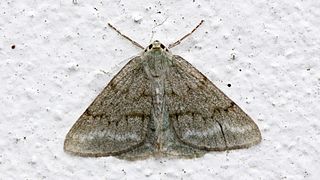
The geometer moths are moths belonging to the family Geometridae of the insect order Lepidoptera, the moths and butterflies. Their scientific name derives from the Ancient Greek geo γεω, and metron μέτρον "measure" in reference to the way their larvae, or "inchworms", appear to "measure the earth" as they move along in a looping fashion. A very large family, it has around 23,000 species of moths described, and over 1400 species from six subfamilies indigenous to North America alone. A well-known member is the peppered moth, Biston betularia, which has been subject of numerous studies in population genetics. Several other geometer moths are notorious pests.

Geometrinae is the nominate subfamily of the geometer moth family (Geometridae). It is strongly split, containing a considerable number of tribes of which most are presently very small or monotypic. These small moths are often a light bluish green, leading to the common name of emerald moths, though a few species called thus are also found in the tribe Campaeini of the Ennominae. In 2018, a phylogeny and classification based on a molecular phylogenetic analysis was published in the Zoological Journal of the Linnean Society in which 13 tribes were accepted.

Scotorythra is a genus of moths in the family Geometridae erected by Arthur Gardiner Butler in 1883. All species of this genus are endemic to Hawaii.

Though small in absolute diversity of genera, the Hemitheini are nonetheless the largest tribes of geometer moths in the subfamily Geometrinae. Like most Geometrinae, they are small greenish "emerald moths". The tribe was first described by Charles Théophile Bruand d'Uzelle in 1846.

Dindicodes is a genus of moths in the family Geometridae.

Sterrhinae is a large subfamily of geometer moths with some 3,000 described species, with more than half belonging to the taxonomically difficult, very diverse genera, Idaea and Scopula. This subfamily was described by Edward Meyrick in 1892. They are the most diverse in the tropics with the number of species decreasing with increasing latitude and elevation.
Scotorythra apicalis is a moth of the family Geometridae. It was first described by Otto Herman Swezey in 1948. It is endemic to the island of Hawaii.
Louis Beethoven Prout (1864–1943) was an English entomologist and musicologist.

The Pseudoterpnini are a tribe of geometer moths in the subfamily Geometrinae. The tribe was described by Warren in 1893. It was alternatively treated as subtribe Pseudoterpniti by Jeremy Daniel Holloway in 1996.
William Warren was an English entomologist who specialised in Lepidoptera.
Dindicodes albodavidaria is a moth of the family Geometridae first described by Xue in 1992. It is found in China.
Dindicodes davidaria is a moth of the family Geometridae first described by Gustave Arthur Poujade in 1895. It is found in western China.
Dindicodes leopardinata is a moth of the family Geometridae first described by Frederic Moore in 1868. It is found in northern India.
Dindicodes euclidiaria is a moth of the family Geometridae first described by Charles Oberthür in 1913. It is found in Tibet.
Dindicodes moelleri is a moth of the family Geometridae first described by William Warren in 1893. It is found in Sikkim, India.
Dindicodes harutai is a moth of the family Geometridae first described by Yazaki in 1992.
Dindicodes costiflavens is a moth of the family Geometridae first described by Wehrli in 1933. It is found in western China.
Dindicodes ectoxantha is a moth of the family Geometridae first described by Wehrli in 1933. It is found in Yunnan, China.
"Dindicodes" vigil is a moth of the family Geometridae first described by Louis Beethoven Prout in 1926. It is found in Myanmar.







